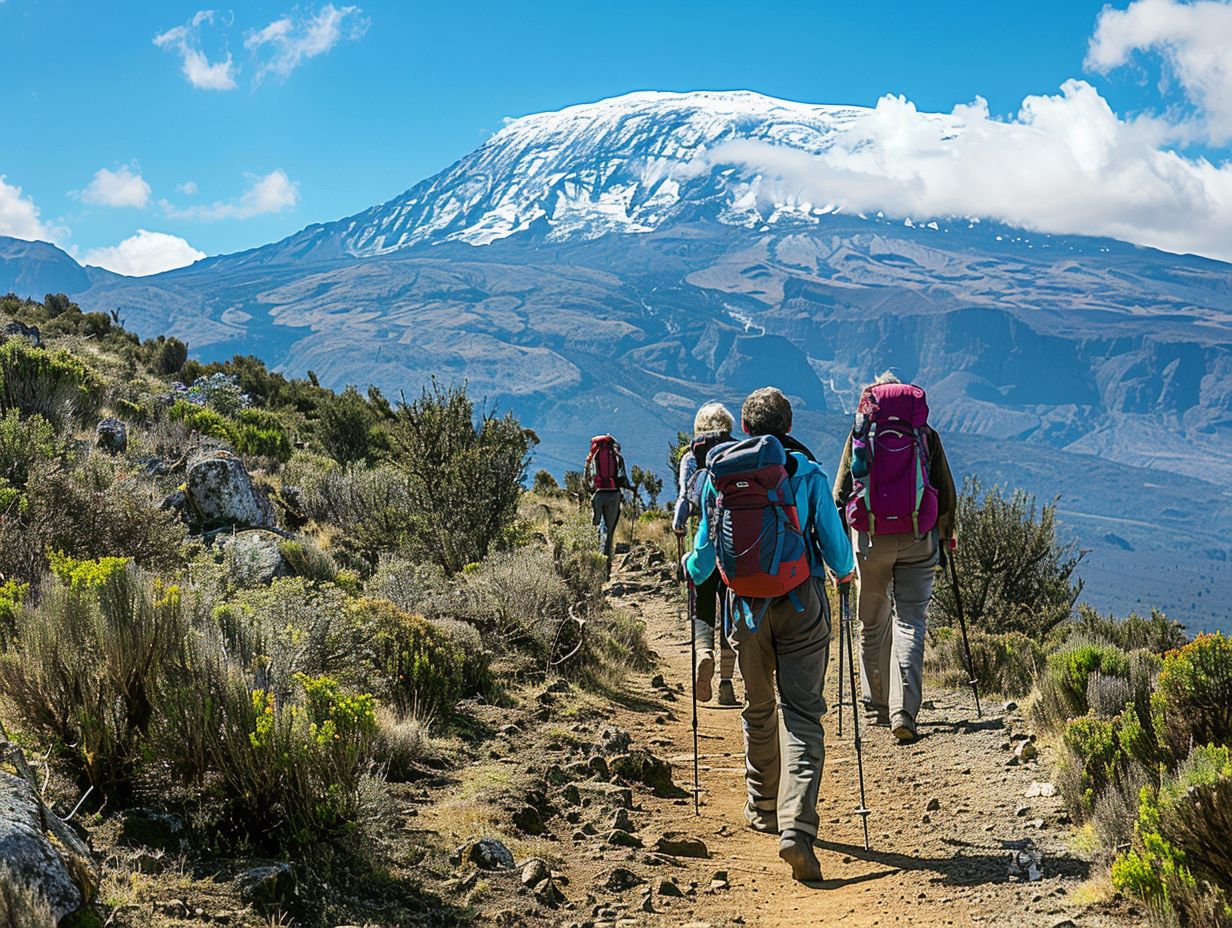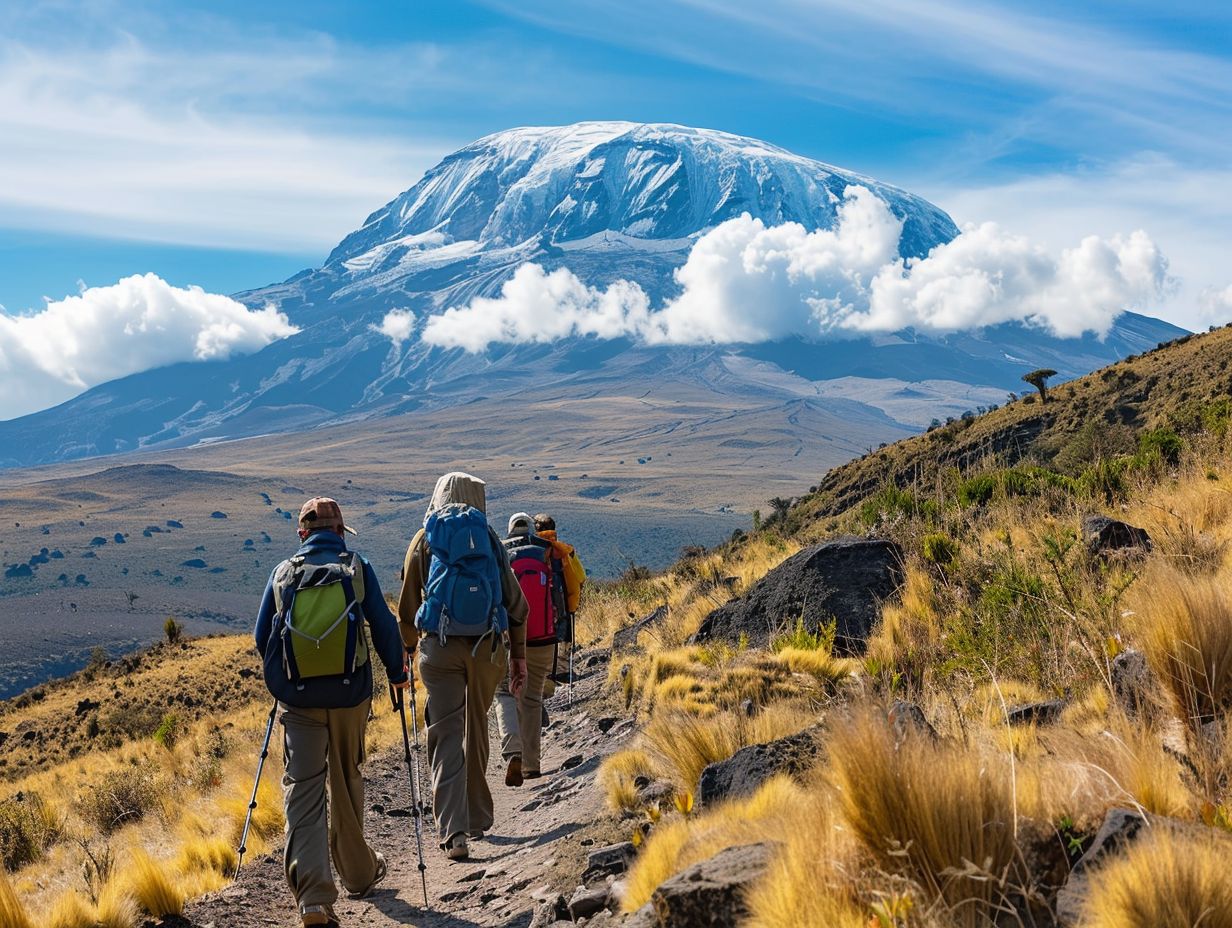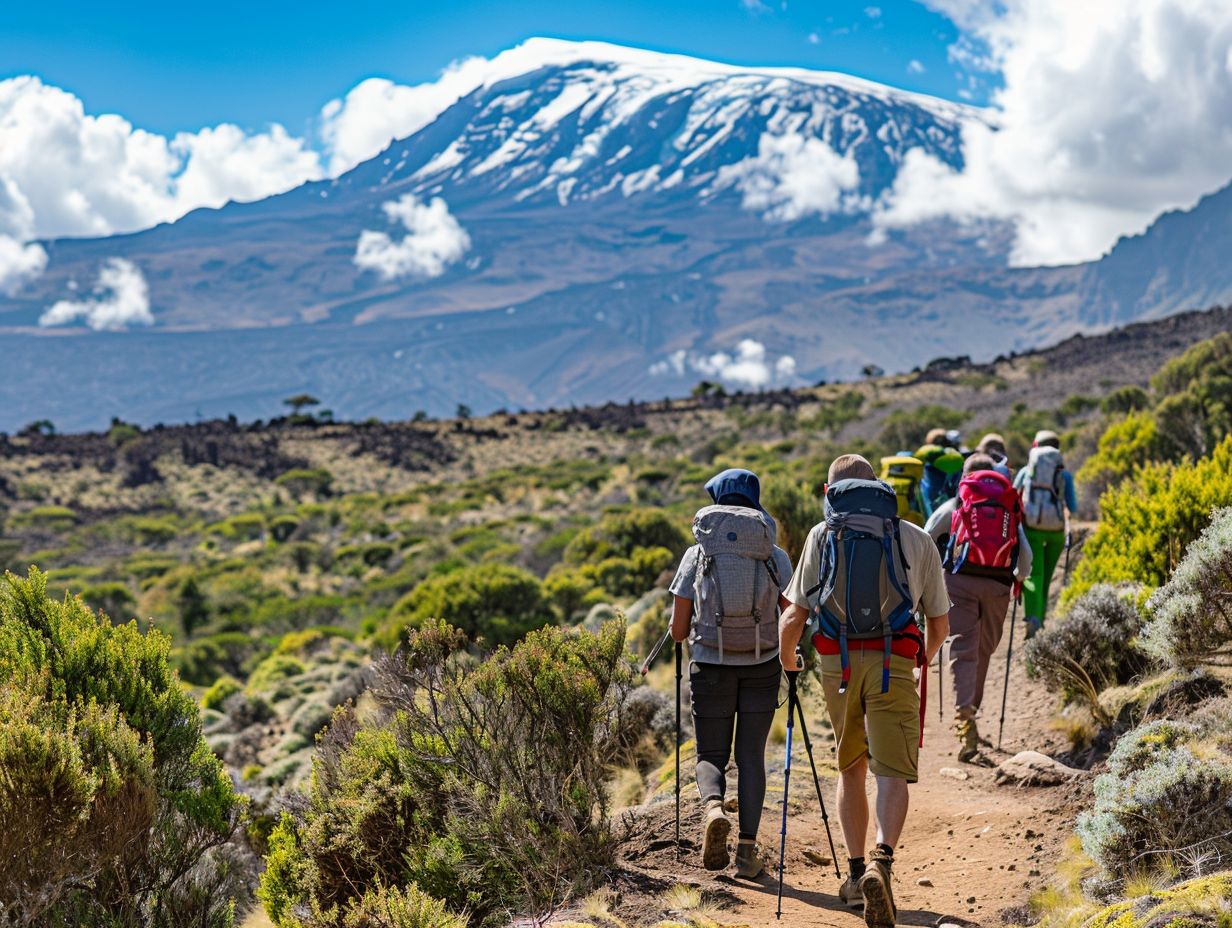
If you’re considering climbing Mount Kilimanjaro, choosing the right route is crucial to your success and enjoyment. With several options to choose from, including the Marangu, Machame, Lemosho, Rongai, and Northern Circuit routes, it’s important to consider factors such as difficulty level, scenery, crowds, cost, and duration.
For beginners, routes like Marangu, Machame, Rongai, and Northern Circuit are recommended. In this article, we’ll explore the different routes, factors to consider, and provide tips for beginners to ensure a successful climb to the summit of Africa’s tallest peak.
Key Takeaways:

- The Marangu Route is the most suitable for beginners due to its gradual ascent and basic accommodations.
- Consider factors like difficulty level, scenery, and cost when choosing a Kilimanjaro route.
- Proper physical training, acclimatization, and packing are essential for beginners attempting to climb Kilimanjaro.
Which Route is Best for Beginners?
For beginners embarking on their first Kilimanjaro climb, routes like Marangu, Machame, Rongai, and Northern Circuit are often recommended for their manageable difficulty levels, supportive infrastructure, and scenic experiences.
Each of these routes has its unique advantages for novice climbers. The Marangu route, also known as the ‘Coca-Cola’ route, is ideal for beginners due to its gradual ascent and comfortable hut accommodations.
On the other hand, the Machame route is favored for its diverse landscapes, providing a well-rounded Kilimanjaro experience.
The Rongai route, coming from the north, offers a quieter and more remote journey, perfect for those seeking solitude in nature.
The Northern Circuit is praised for its longer duration, allowing for better acclimatization and higher summit success rates.
Marangu Route

The Marangu Route is considered a good choice for beginners due to its gradual ascent, hut accommodations, and well-defined paths. Climbers can enjoy a comfortable trek with relatively stable conditions while acclimatizing to the altitude.
Known as the ‘Coca-Cola Route’ for its popularity and infrastructure, Marangu offers a unique experience with dormitory-style sleeping arrangements in rustic huts along the trail, providing a cozy atmosphere for novice climbers.
The route’s shorter duration compared to others like the Machame or Lemosho allows beginners to acclimatize gradually, reducing the risk of altitude sickness. Guided tours are common for first-time trekkers, offering valuable support and knowledge for a safe and enjoyable climb.
Machame Route
While the Machame Route presents a moderate challenge, it is also suitable for beginners seeking a more adventurous climb. This route offers diverse landscapes, camping experiences, and ample opportunities for acclimatization.
The Machame Route, often dubbed as the ‘Whiskey Route,’ is favored by novice climbers due to its gradual ascent profile, allowing ample time for the body to acclimate to the altitude changes. This six to seven-day trek leads climbers through lush rainforests, striking heathlands, and challenging rock formations.
One of the standout features of this route is the stunning summit approach through the Southern Glaciers, offering breathtaking panoramic views and a sense of achievement like no other.
While beginners may find the journey physically demanding, the rewards are unparalleled – from witnessing the sunrise from Uhuru Peak to forging lasting bonds with fellow climbers sharing the same awe-inspiring experience.
Rongai Route
The Rongai Route provides a less strenuous and more gradual ascent option for beginner climbers. With stunning views and serene surroundings, this route offers a balanced mix of challenge and comfort for those new to high-altitude trekking.
Novice climbers often find the Rongai Route appealing due to its gentle slopes and less crowded trails, allowing them to acclimatize at a manageable pace. The gradual ascent on this route provides ample time for the body to adjust to the increasing altitude, reducing the risk of altitude sickness.
Compared to other popular routes like the Machame or Marangu, the Rongai Route is known for its tranquility and panoramic vistas. The trail winds through diverse landscapes, offering glimpses of the vast African plains and the snow-capped summit of Kilimanjaro.
Northern Circuit Route
The Northern Circuit Route is ideal for beginners due to its gradual acclimatization profile, stunning landscapes, and fewer crowds.
One of the standout features of the Northern Circuit Route is the opportunity it provides for climbers to acclimatize slowly to the altitude, reducing the risk of altitude sickness. This gradual ascent allows novice climbers to adjust to the high altitude conditions, making the trek more comfortable and safer.
The route boasts breathtaking landscapes that showcase the diversity of Kilimanjaro’s ecosystems, from lush rainforests to alpine moorlands. For beginner adventurers, experiencing these varied environments can add an extra layer of excitement and wonder to the climb.
In terms of safety, the Northern Circuit Route is known for its well-maintained trails, experienced guides, and reliable support staff. These factors contribute to creating a secure environment for novice climbers, giving them the confidence to focus on enjoying the journey and reaching the summit.
Tips for Beginners Climbing Mount Kilimanjaro
Embarking on a Kilimanjaro climb as a beginner can be a rewarding but challenging experience. To enhance your journey and increase your chances of summiting successfully, consider these essential tips for novice climbers.
One crucial aspect of preparing for a Kilimanjaro ascent is physical training. Begin with cardio exercises like running, hiking, and cycling to build endurance. Strength training focusing on legs, core, and upper body will also be beneficial for the trek’s demands.
Remember, acclimatization is key to avoid altitude sickness; take time to adjust to the changing altitudes and consider shorter hikes at higher elevations before attempting the summit.
Regarding gear preparation, invest in quality trekking essentials like sturdy hiking boots, moisture-wicking clothing, a reliable backpack, a warm sleeping bag, and proper layering options.
Don’t overlook the importance of a good pair of socks and well-fitted gloves. While it’s tempting to pack light, ensure you have all the necessary gear to stay comfortable and safe during your climb.
Train and Prepare Physically
Physical conditioning is vital for beginner climbers tackling Kilimanjaro. Prioritize your fitness regimen, including cardiovascular exercises, strength training, and endurance building, to prepare your body for the rigors of high-altitude trekking.
Along with regular cardiovascular workouts like running, cycling, or swimming, novice climbers should also focus on specific strength training exercises targeting muscle groups used during climbing, such as shoulders, back, and legs.
Integrating bodyweight exercises like push-ups, planks, and squats can help improve overall strength and stability, crucial for navigating steep slopes and rocky terrain during the ascent.
Don’t underestimate the importance of core strength, as it plays a crucial role in maintaining balance and stability on challenging sections of the climb. Include exercises like Russian twists, leg raises, and mountain climbers to strengthen your core muscles.
Acclimatize Properly
Proper acclimatization is crucial for beginner climbers on Kilimanjaro to mitigate the risks of altitude-related illnesses. Ascend slowly, stay hydrated, and listen to your body’s signals to ensure a safe and successful climb.
As a novice climber, your body needs time to adjust to the decreasing oxygen levels at higher altitudes. This process of acclimatization can significantly impact your overall trekking experience.
Gradual ascent is key, allowing your body to adapt to the reduced air pressure and lower oxygen levels. Consider taking rest days during your climb to aid in acclimatization and reduce the chances of altitude sickness.
Maintaining proper hydration levels is essential to support your body’s adjustment to higher elevations. Dehydration can worsen altitude-related symptoms, so make sure to drink plenty of water throughout your journey and avoid excessive caffeine or alcohol consumption.
Pack Appropriately

Packing the right gear and equipment is essential for beginner climbers on Kilimanjaro to ensure comfort, safety, and preparedness throughout the trek. Make a checklist of essential items, including clothing, footwear, camping gear, and personal supplies.
Footwear is one of the most critical considerations. Invest in sturdy hiking boots with good ankle support. Ensure they are broken in before the climb to prevent discomfort and blisters. Pack moisture-wicking socks to keep your feet dry and comfortable during long treks.
It’s crucial to have a reliable and well-fitted backpack that can accommodate all your essentials without being too heavy. Look for one with multiple compartments for easy organization and accessibility. Remember to pack a hydration system or water bottles to stay adequately hydrated throughout your journey.
Listen to Your Guide
Heeding the advice and instructions of your experienced guide is essential for beginner climbers on Kilimanjaro.
Guides play a crucial role not only in navigating the challenging terrain but also in providing motivation and encouragement along the ascent.
Their expertise in assessing weather conditions, identifying potential hazards, and making quick decisions is invaluable in ensuring the safety of climbers. Many novice climbers have shared how their guides’ knowledge of the mountain’s routes and nuances has enhanced their overall experience, making them feel more confident and secure.
Interacting effectively with your guide is key; communicating openly about any concerns or physical limitations can help them tailor the climb to suit your abilities.
Building a rapport with your guide fosters a sense of trust and teamwork, creating a harmonious dynamic that enhances the climbing experience for both parties. Remember, your guide is there not just to lead but to support and educate you, enriching your journey up Kilimanjaro.
Enjoy the Experience
As a beginner climber on Kilimanjaro, remember to savor every moment of this extraordinary adventure. Celebrate your progress, embrace the challenges, and relish the breathtaking landscapes and wildlife encounters along the way.
Each step you take up the rugged terrain brings you closer to achieving a dream that only a few dare to pursue. The sense of accomplishment as you conquer each elevation milestone is unparalleled.
Immerse yourself in the natural beauty that surrounds you—the rustling leaves, the chirping birds, the distant roar of a waterfall, all whispering tales of the awe-inspiring world you are exploring.
Every rock you climb and every slope you overcome is a testament to your strength and determination. Remember, reaching the summit is not just about physical prowess; it’s also about the mental resilience and unwavering spirit within you that propels you forward.
Frequently Asked Questions
What is the best Kilimanjaro route for beginners?
The best Kilimanjaro route for beginners is the Marangu route. It is the only route on the mountain with huts for accommodation, making it the most comfortable option for first-timers.
Why is the Marangu route recommended for beginners?
The Marangu route has a gradual ascent, allowing for better acclimatization and therefore reducing the risk of altitude sickness. It is also the shortest route, taking only 5-6 days to reach the summit.
What makes the Marangu route easier than other routes?
The Marangu route is easier because it has a more gradual slope and well-maintained trails. The huts also provide shelter from the elements, making it less physically demanding compared to camping on other routes.
Are there any other Kilimanjaro routes suitable for beginners?
Yes, the Rongai route is also a good option for beginners. It is a longer route, taking 6-7 days, but has a similar gradual slope and huts for accommodation.
What is the success rate for beginners on the Marangu route?
The success rate for beginners on the Marangu route is approximately 80%. This is due to the shorter duration of the route and the huts for accommodation, which provide comfort and rest during the trek.
What are some tips for beginners attempting the Marangu route?
Some tips for beginners on the Marangu route include training beforehand, staying hydrated, and taking time to acclimatize. It is also recommended to hire a guide and porter to ensure a safe and successful trek.